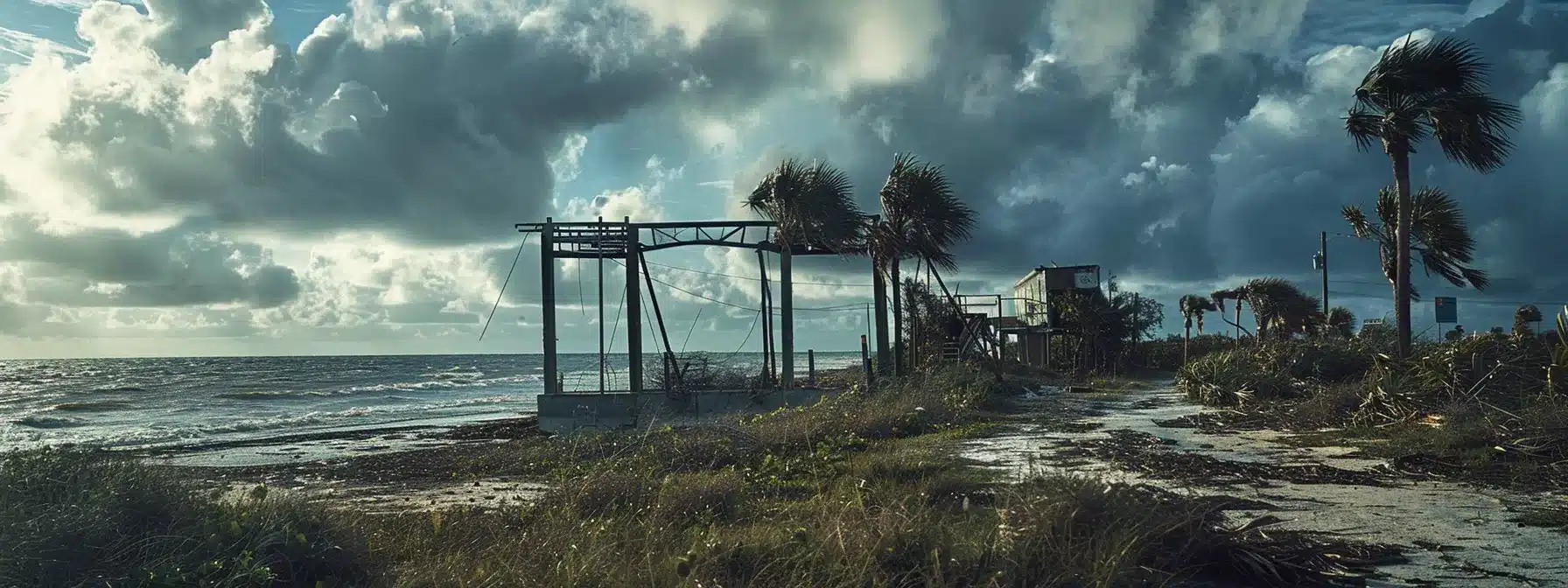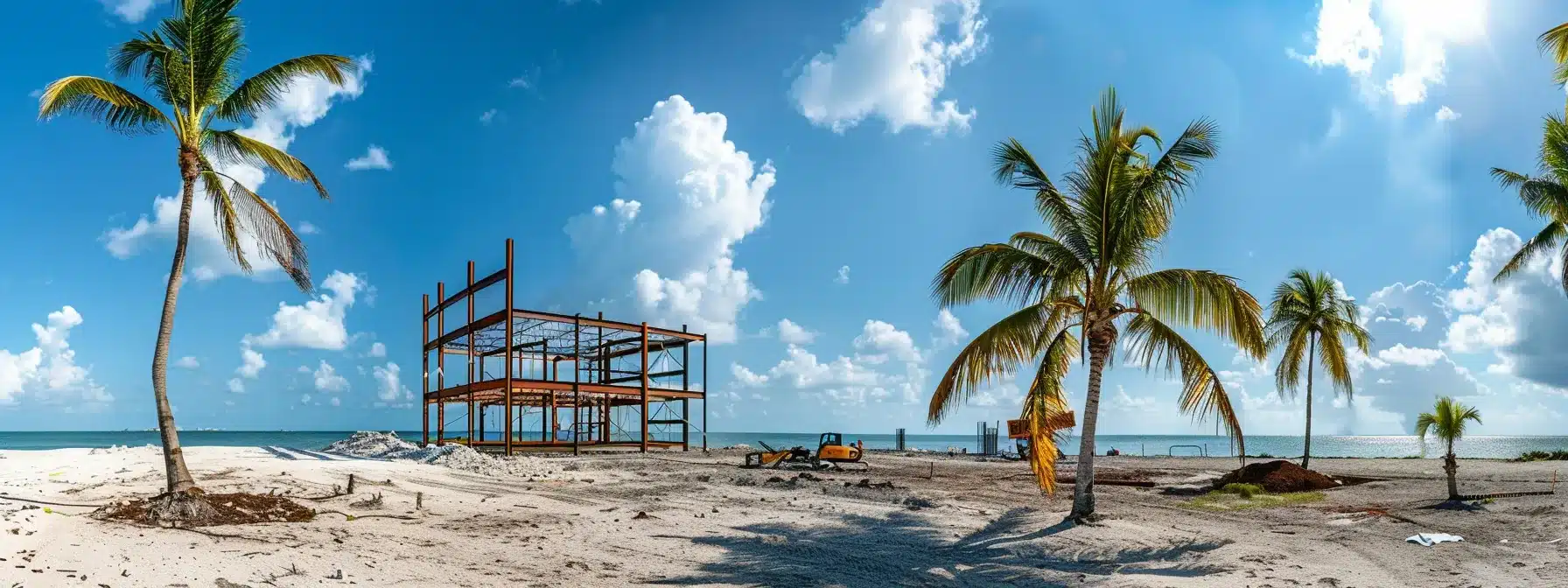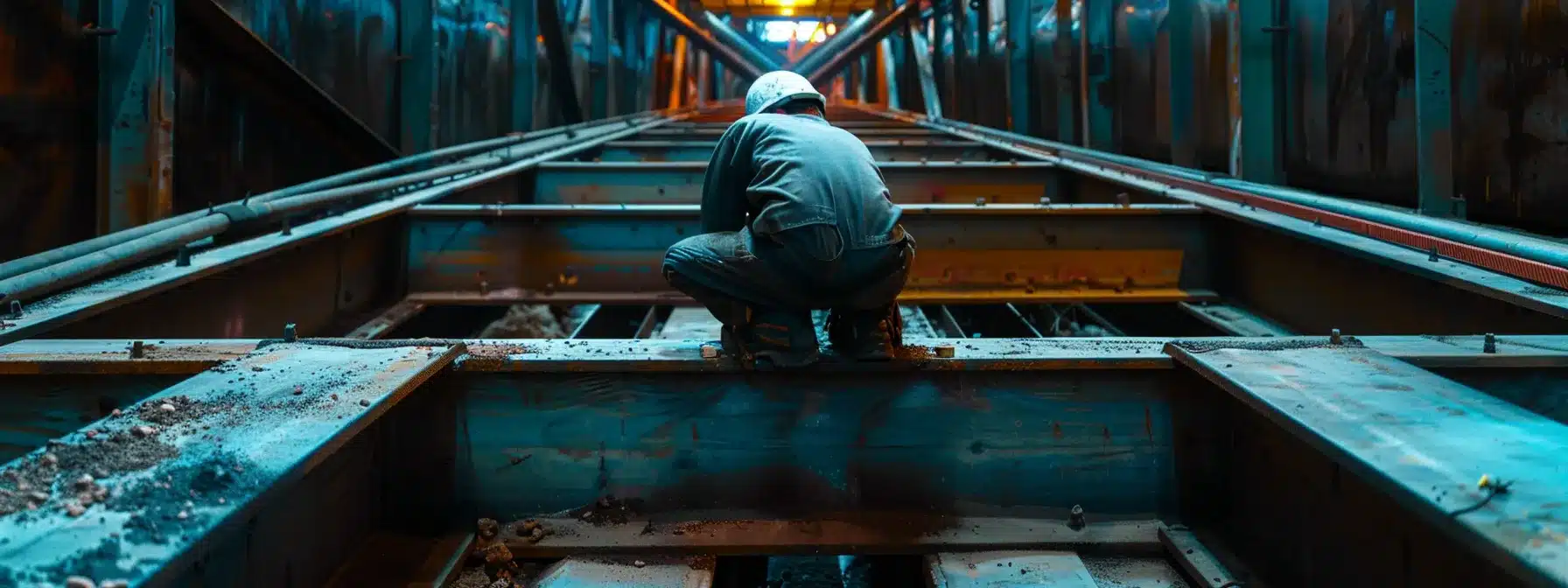Hurricane-proof steel framing is essential for protecting your investments in Florida, where high winds can severely damage homes and buildings. Did you know that homes with advanced steel framing can significantly lower home insurance premiums? In this post, I will discuss the essential techniques for creating resilient steel frames that withstand hurricanes, adherence to Florida’s building codes, and common pitfalls to avoid. By implementing these hurricane-proof methods, you can ensure the safety of your structure and potentially reduce your insurance costs. Let’s tackle the challenges of strong winds together and build a secure future for your projects.
Understanding the Importance of Hurricane-Proof Steel Framing in Florida

In Florida, it’s essential to assess the risks posed by hurricane season. Understanding the advantages of Elite Steel framing over traditional building methods can significantly enhance structural integrity during storms. I’ll examine how steel framing holds up against stress, the role of inspection in securing ties, and the effectiveness of foam and deck materials in hurricane-proofing constructions.
Assessing the Risks Posed by Florida’s Hurricane Season
Florida’s hurricane season presents significant risks that every builder must acknowledge. The combination of torrential rains, high winds, and potential flooding demands robust construction techniques. By integrating innovative materials like laminated glass and constructing with a rainscreen system, I can enhance the resilience of structures against nature’s fury. Additionally, using steel joists instead of traditional wood framing markedly improves structural integrity, making it a decisive factor in hurricane preparedness.
| Risk Factor | Description | Mitigation Strategy |
|---|---|---|
| High Winds | Category 5 hurricanes can produce winds exceeding 157 mph. | Utilize hurricane-proof steel framing and laminated glass windows. |
| Heavy Rains | Extreme rainfall can lead to flooding and accumulated water damage. | Install a rainscreen system for effective water drainage. |
| Flooding | Flood-prone areas can suffer extensive structural damage. | Raise structures and employ flood-resistant materials. |
Advantages of Steel Framing in Storm-Prone Regions
One of the key advantages of steel framing in storm-prone regions is its superior strength compared to traditional materials. Steel‘s durability means that when I incorporate it into a concrete slab foundation, supported by rebar, the overall structure can better withstand the severe weather conditions commonly found in Florida. Additionally, using steel rafters minimizes the risk of roof failure during high winds, ensuring that buildings remain secure and intact even in extreme situations.
Comparing Steel Framing to Traditional Building Methods
When I compare steel framing to traditional building methods, the advantages become clear, especially in hurricane-prone Florida. Steel, when combined with cement and bitumen for proper sealing, meets rigorous building codes designed to withstand natural disasters. Traditional wood framing may fail under extreme pressure from high winds and heavy rains, while steel framing provides a sturdy, hurricane-proof solution that enhances the safety and longevity of structures.
Essential Steel Framing Techniques for Hurricane Resistance

Designing frames to withstand high wind loads is critical in hurricane-prone Florida. I emphasize reinforcing connections for enhanced stability, which plays a vital role in structural resilience. Incorporating cross-bracing and shear walls further increases strength, while utilizing galvanized steel combats corrosion, ensuring longevity. Additionally, integrating materials like polystyrene, wood, and drywall can optimize energy efficiency and mass for superior performance during extreme weather.
Designing Frames to Withstand High Wind Loads
When designing frames to withstand high wind loads, I prioritize the use of high-quality steel as the primary building material. This metal‘s intrinsic strength allows the structure to resist extreme pressures common during hurricanes. To enhance the durability of steel framing in hurricane resistant homes, I utilize effective sealants that prevent moisture intrusion and protect against corrosion, ensuring that the entire framing system remains robust over time.
Reinforcing Connections for Enhanced Stability
Reinforcing connections is key to achieving enhanced stability in hurricane-proof steel framing. In my experience, using properly designed connections not only lowers the risk of structural failure during extreme weather but also contributes to the overall sustainability of the building. For instance, I ensure that the soffit and siding are securely connected to the framing, which helps protect against wind uplift and mitigates damage to the asphalt shingle roofing during storms.
Incorporating Cross-Bracing and Shear Walls
Incorporating cross-bracing and shear walls into steel framing significantly enhances a structure’s resistance to hurricane-force winds. I find that adding a few strategically placed aluminum anchors every inch on the shear walls not only boosts the overall stability but also minimizes the risk of water damage during storms. This proactive approach strengthens the wall‘s integrity, ensuring that it withstands the extreme pressures that often accompany Florida’s hurricanes.
| Technique | Description | Benefit |
|---|---|---|
| Cross-Bracing | Diagonal supports that add rigidity to the frame. | Improves stability against lateral forces from high winds. |
| Shear Walls | Vertical walls designed to resist lateral loads. | Enhances structural integrity and minimizes water damage risk. |
| Aluminum Anchors | Fasteners installed at regular intervals along walls. | Increases resistance to wind and potential storm damage. |
Utilizing Galvanized Steel to Combat Corrosion
Utilizing galvanized steel in hurricane-proof construction significantly enhances a structure’s ability to withstand storms while combating corrosion. I have found that applying a protective layer to steel framing helps protect it from the detrimental effects of water and debris exposure, which is common in harsh weather conditions. Additionally, this approach integrates seamlessly with insulation and strap systems, reinforcing overall structural integrity and ensuring that the framing remains stable, reducing the risk of damage from lumber decay or weakened connections during severe storms.
Step-by-Step Guide to Implementing Hurricane-Proof Steel Framing

In this guide, I will take you through the essential steps to implement hurricane-proof steel framing in Florida. We’ll start with planning and preparing the construction site to ensure safety and compliance, followed by selecting the appropriate steel grade and components that can withstand high wind speeds. Next, I’ll cover assembling the steel frame with precision, paying attention to structures like hip roofs. Lastly, we will focus on the importance of inspecting the structure to ensure it meets safety standards, minimizing risks associated with hurricanes like Hurricane Michael.
Planning and Preparing the Construction Site
Planning and preparing the construction site is a critical first step in implementing hurricane-proof steel framing. I focus on creating a secure environment by evaluating the site’s soil stability and elevation, which helps mitigate flooding risks. Additionally, I prioritize the use of advanced materials like polyvinyl butyral for window laminates and spray foam for insulation, ensuring minimal air infiltration while enhancing structural durability. By incorporating these techniques, I set a solid foundation that supports the integrity of the overall construction, reducing vulnerabilities during hurricane events.
Selecting the Appropriate Steel Grade and Components
Selecting the appropriate steel grade and components is fundamental to ensuring the durability and safety of hurricane-proof steel framing. I recommend using high-strength steel, such as ASTM A36 or A992, as these grades possess excellent resistance to extreme weather forces while minimizing moisture-related issues. Additionally, using components designed for superior drainage can significantly enhance the framework’s integrity, reducing the risk of water accumulation that may weaken the structure over time:
- Identify high-strength steel grades suitable for harsh conditions.
- Evaluate components for moisture resistance and durability.
- Incorporate drainage solutions to prevent water damage.
Assembling the Steel Frame With Precision
As I assemble the steel frame for hurricane-proof buildings, precision is paramount. I focus on ensuring that all connections are tight and secure, which plays a critical role in preventing failure during intense storms. For example, I pay special attention to how windows and doors integrate with the framing; their proper installation significantly reduces the risk of projectiles breaking through during high winds. Additionally, I select high-quality materials that resist corrosion, maintaining the integrity of the frame over time and addressing common vulnerabilities in storm-prone areas like Florida.
Inspecting the Structure for Compliance and Safety
Inspecting the structure for compliance and safety is a critical step in hurricane-proof steel framing. I meticulously examine the connections between the steel trusses and expect fasteners to meet stringent code requirements, ensuring that the connections can withstand the high winds typical along the coast. Additionally, I assess the masonry and concrete elements of the structure, looking for any signs of potential weaknesses that could compromise integrity during a storm. This rigorous inspection process not only ensures that my builds are safe but also instills confidence in homeowners facing the challenges of Florida’s hurricane season.
Adhering to Florida’s Building Codes and Regulations

Understanding local hurricane resistance requirements is essential for effective construction in Florida. I will navigate the permitting and approval processes, ensuring every steel frame meets the Florida Building Code. Additionally, I’ll address how to stay updated on code changes and amendments, making sure my framing techniques are compliant and effective against mold, reinforced concrete, and other potential hazards.
Understanding Local Hurricane Resistance Requirements
Understanding local hurricane resistance requirements is vital for constructing a hurricane-proof house in Florida. I focus on the specific codes that dictate the necessary pressure thresholds for materials and framing techniques, ensuring that all elements, from steel screws to fiberglass insulation, comply with these standards. This compliance not only enhances the structure’s resilience but also aligns with the architectural principles that govern safe and effective building practices in our hurricane-prone environment.
Navigating Permits and Approval Processes
Navigating the permits and approval processes in Florida requires diligence and attention to detail. I focus on understanding local regulations to ensure that every hurricane-proof steel framing project meets efficiency and compliance standards. Working closely with local authorities allows me to streamline the approval process, ultimately saving time and reducing potential setbacks.
- Understand local building codes and regulations.
- Prepare necessary documentation for permits.
- Engage with local authorities for smoother approvals.
- Maintain efficiency by streamlining the submission process.
Ensuring Compliance With the Florida Building Code
Ensuring compliance with the Florida Building Code is essential for any hurricane-proof steel framing project. I commit to thoroughly understanding the specific regulations that govern structural integrity in high-wind zones, which include material specifications and design loads. By adhering to these guidelines, I can create resilient structures that not only meet safety standards but also provide peace of mind for homeowners facing the challenges of Florida’s hurricane season.
Staying Updated on Code Changes and Amendments
Staying updated on code changes and amendments is critical for me as a builder focused on hurricane-proof steel framing in Florida. I regularly review local government websites and participate in professional associations to keep informed about any modifications to the Florida Building Code. This proactive approach ensures that my construction techniques remain effective, compliant, and aligned with best practices for enhancing structural resilience against hurricanes.
- Regularly review local government websites for updates.
- Participate in professional associations for networking and knowledge sharing.
- Adapt construction techniques based on current building codes.
Avoiding Common Mistakes in Steel Framing Construction

Avoiding common mistakes in steel framing construction is crucial for creating resilient structures that can withstand Florida’s hurricanes. I focus on preventing material corrosion and degradation, addressing thermal expansion challenges, ensuring proper alignment and load distribution, and overcoming specific issues related to coastal construction sites. These practical insights will help enhance the integrity and longevity of any hurricane-proof building project.
Preventing Material Corrosion and Degradation
Preventing material corrosion and degradation is a critical focus in my approach to steel framing construction, especially in Florida’s humid and hurricane-prone environment. I prioritize using galvanized steel or other corrosion-resistant materials to enhance longevity and maintain structural integrity over time. Furthermore, I ensure that all exposed steel components are treated with effective sealants, which helps prevent moisture infiltration and combat the potential deterioration from salt air, a common concern for coastal builds.
Addressing Thermal Expansion in Steel Structures
Addressing thermal expansion in steel structures is vital to maintaining their integrity over time, especially in Florida’s climate where temperature fluctuations can be significant. I ensure that I incorporate expansion joints into my designs to allow for the natural movement of steel as temperatures change. This proactive approach minimizes stress on connections and prevents buckling, ultimately enhancing the durability of my hurricane-proof steel framing.
Ensuring Proper Alignment and Load Distribution
Ensuring proper alignment and load distribution in steel framing is crucial for creating structures that can withstand the intense forces of hurricanes. I make it a priority to check all connections and alignments during assembly, as even minor misalignments can lead to significant weaknesses under stress. By utilizing laser levels and professional-grade tools, I can ensure that the framing components are perfectly aligned, which not only increases structural strength but also enhances the overall safety and stability of the building, making it more resilient against Florida’s violent storms.
Overcoming Challenges With Coastal Construction Sites
Overcoming challenges with coastal construction sites demands a strategic approach to ensure the integrity of hurricane-proof steel framing. In my experience, I encounter unique issues such as high salinity, soil erosion, and fluctuating water tables that can impact the durability of the building materials. By choosing corrosion-resistant steel and implementing proper drainage techniques, I can effectively protect structures from the severe environmental factors common in Florida, ultimately enhancing their resilience against hurricanes.
| Challenge | Description | Solution |
|---|---|---|
| Salinity | High salt levels in the coastal environment can accelerate corrosion. | Utilize corrosion-resistant materials and protective coatings. |
| Soil Erosion | Shifting soil can weaken the foundation over time. | Incorporate deep pilings and proper grading to stabilize soil. |
| Fluctuating Water Tables | Water levels can rise and fall, affecting structural stability. | Implement comprehensive drainage systems to manage water flow. |
Learning From Successful Hurricane-Proof Steel Structures in Florida

In this section, I will examine successful steel-framed homes that have withstood major hurricanes, showcasing real-world resilience. I will also address innovations in steel framing technology that enhance durability and safety. Finally, I’ll share expert insights and best practices from industry leaders, providing practical knowledge to help you master hurricane-proof steel framing techniques in Florida.
Case Study: Steel-Framed Homes That Withstood Major Hurricanes
In observing steel-framed homes that have weathered major hurricanes like Irma and Michael, I have noted their construction techniques and material choices play a pivotal role in their resilience. For instance, structures incorporating steel reinforcements and impact-resistant windows consistently demonstrate superior performance against high winds and flying debris. These real-world examples not only highlight successful designs but also serve as a benchmark for implementing hurricane-proof steel framing techniques effectively.
- Steel reinforcements enhance structural integrity.
- Impact-resistant windows reduce the risk of damage from debris.
- Successful designs inspire new construction projects.
Innovations in Steel Framing Technology
Innovations in steel framing technology play a crucial role in enhancing the durability and resilience of structures in Florida, especially those designed to withstand hurricanes. I’ve recently focused on integrating advanced coating processes and smart materials into steel construction. These innovations not only reduce corrosion risks but also allow for real-time structural assessments during storm conditions, giving builders and homeowners peace of mind in knowing their homes are equipped to face severe weather events.
Expert Insights and Best Practices From Industry Leaders
As I explore the best practices from industry leaders in hurricane-proof steel framing, I find that collaboration and continuous education are key for ensuring success in construction. Engaging with experienced professionals at workshops and conferences has allowed me to adopt innovative techniques and materials that address common vulnerabilities in hurricane-prone areas. By integrating lessons learned from past challenges and successful projects, I can implement effective strategies that enhance the resilience of our structures and better protect homeowners during storms:
| Best Practice | Description | Benefit |
|---|---|---|
| Collaboration | Working with experienced builders, architects, and engineers. | Brings diverse insights and enhances design solutions. |
| Innovative Materials | Utilizing advanced steel coatings and impact-resistant glass. | Increases durability and structural integrity against storms. |
| Continuous Education | Participating in industry training and conferences. | Stays updated on best practices and emerging techniques. |
Conclusion
Mastering hurricane-proof steel framing techniques is crucial for ensuring safety and structural durability in Florida’s challenging climate. Using robust materials like galvanized steel, incorporating advanced design strategies such as cross-bracing, and adhering to local building codes significantly enhances a home’s resilience against severe storms. At Elite Steel, we’re committed to providing cutting-edge steel solutions that stand up to nature’s fiercest hurricanes.
Let us help you build stronger, safer, and more reliable structures. Contact Elite Steel today at 1-904-799-6499 or visit our website at elitesteel.com to learn more about our services and how we can assist with your next project.

